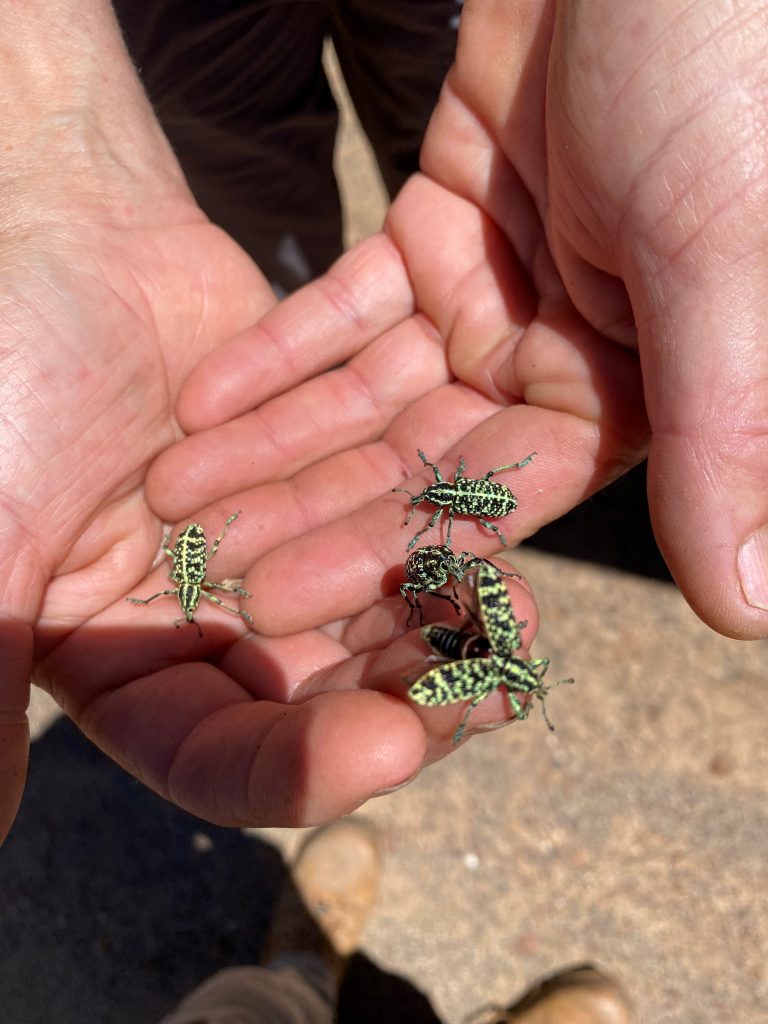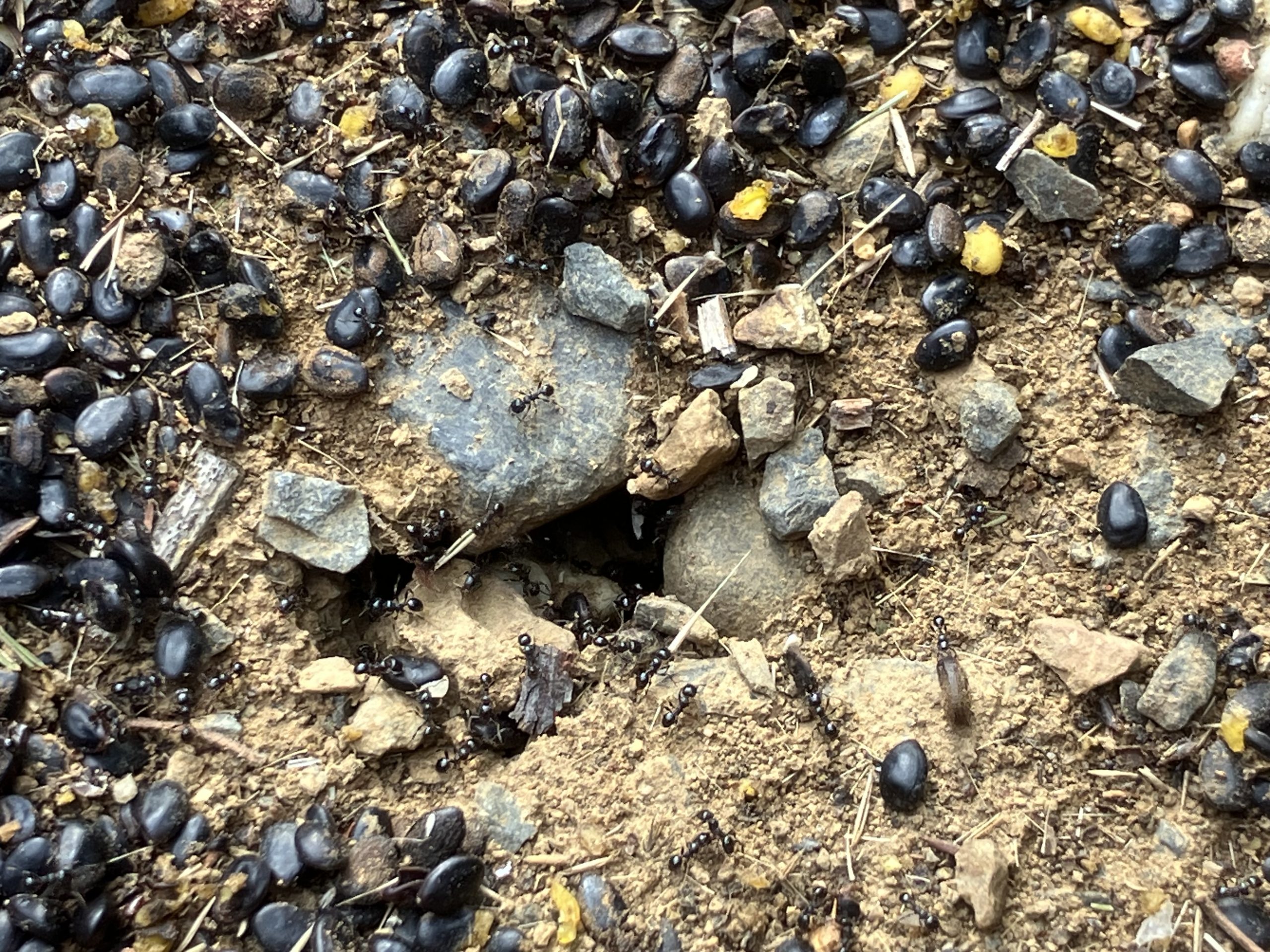Have you ever crumbled a dry pod in your fingers – scattering seed? Allowed a bucket of berries to rot and smell – then wash and sieve them to find shiny black jewel-like seeds within the mess? Had a bucket of seed flow through your fingers like a viscous liquid – the promise of countless new potential plants at your finger-tips or plucked Bidgee Widgee seeds from your socks or your dog’s muzzle? Seeds – endlessly variable in how parent plants distribute their offspring – whether it be wind, fur, consumed or a tiny, pod explosion. Every seed, some miniscule as dust, some hidden in pods or fruit – a perfect package ready to grow in the right conditions.
I am the daughter of a horticulturalist. The sounds of latin were an early second language and observing plants and where they live ingrained in my DNA. Every walk, every holiday – there was always a plant to be found and admired, and it if was seeding, a pocket in your jeans to be filled with seed – ready to germinate and grow at home. I carry this tradition every day – the endless fascination of how a plant is developing its seed and always a pocket full of seed on the return from a walk or holiday.
Diversity
Every species has its unique take on producing seed. But seed, and its abundance, in fact its explosion, in early summer, is also the beginning of the food cycle.
Often a species has its own unique collection of insects. Acacia paradoxa, Hedge Wattle, is one of the worst plants to harvest. With fine, needle-sharp prickles, it is impossible to collect without splinters in your fingers. To make harvesting bearable, thick welding gloves are a sensible move but leave you with little dexterity. Loosely grabbing a branch and gently stripping pods into a bucket – leaves, pods and insects fall indiscriminately. A little patch of Hedge Wattle in Grey Box woodland on the edge of Seymour, treated as a bit of a local wasteland, produced the most startling and dazzling array of insects as well as seeds. Not only the nesting birds find the prickly plant a safe haven it seems. Another favourite, Dodonea viscosa ssp angustissima, Narrow leaved Hop bush – papery pods that split 3 ways with seeds nestled within each papery wing. As these are gently brushed from the shrub, always there are beautiful harlequin beetles that fall into your bucket. Its quite common for our seed collecting team to spend morning tea or lunch with heads in our seed buckets, identifying the myriads of spiders, beetles and bugs moving through the pods. We leave our bags open and allow them to escape through the day.

Rarely seen Jewelled Weevils – found a good home in the prickles of Hedge Wattle
Abundance
Most plants produce a dazzling abundance of seed. The eucalypts, with tiny seeds within each wooden fruit, produce millions of seeds per tree most years. Wattle seed pods drip with seed – each gram with the potential for about 100 new plants. Some of the berry producers – like the Dianella lilies, are not as prolific, but encase each package of seeds in a berry – ready to be eaten and defaecated in a neat package of compost ready to germinate. Where do all these seeds go? Is it just a profligate waste of resources?
As a wild seed collector, our permit stipulates that we collect only 10% of the seed from a plant. The parrots don’t like to be beholden to these rules. But they are generally messy eaters – eating some then dropping plenty to the ground in branches or just shaking them off. Some of the seeds might stick to furry coats and get scratched or rubbed off as an animal travels around. Ants carry seeds back to their holes, dragging seeds underground and depositing the wasted fluff or in some cases, the actual seed, outside their holes. Some seed winds up in the soil – the natural seedbank. This seed is like a promise to the future of potential germination. At the Arb, some of the hard coated pea seeds have germinated after a burn or soil disturbance. Some plants have germinated from seed that we guess could have been 150 years old!

Ants collecting Silver Wattle. The funicle is harvested and the seed discarded. But in the process, the ants scratch the hard seed coat of the wattle seed – priming it for germination
Ripe Seed
Getting our timing right when we harvest seed is an art. Too early and seed is still green – it might be soft and milky when squashed and a bit resistant to pull from a plant. It seems the plant is not ready to relinquish its seed just yet.
When seed is ripe, it almost falls into your hand – its ready for collection and distribution. We can become part of the grand plan of collecting and sharing these plant genetics.
There are equally times when we are too late. Often only by hours. Daviesia has a habit of popping on mass – often on 1 day across vast areas. The pods are dry, the temperature is just right, and all the pods you have watched for a week pop on their own cue – flinging seed out to the world. Alternatively, the parrots beat you, or a summer storm sweeps through -the winds and rain effectively stripping the plant of seed. It is surprising, from about the 200 plant species we harvest from, just how rarely we get our timing just right.
An annual reflection of climate
I’ve been asked recently, ‘how do you think plants will respond to climate change with seed production?’
This is an easy answer – those of us who are avid seed collectors have been watching the flowering and seed response of plants for the past 20 years or so.
Each year, and each species, is a little variable with seed abundance and viability. This year, with a very dry spring, there has been little seed set. When we open a wattle pod this year, maybe 1 or 2 seeds look black and plump – the rest look shrivelled and sunken. If we were to grow them out, probably only those 1 or 2 shiny plump seeds will germinate. Instead, we sieve and vacuum all of the light, shrunken seeds from the batch to leave the good, viable seeds.
The wet year or 2022, we thought we would be in for a bumper seed crop. Enough rain in winter/spring often means plants aren’t stressed and seed is abundant. However, extreme rains and cool temperatures meant little flowering and pollination – once again, a poor seed year.
Some plants, Acacia implexa, Lightwood Wattle and Acacia mearnsii, Black Wattle, both common and widespread plants, seed mostly every second year. However, between 2011 – 2021, these plants hardly produced seed across our catchment. It appears they need 2 years in a row of reasonable, average rainfall. Some plants of course, still thrive in these conditions – adding a layer of confusion to the overall theme. But overall, other than 2011,2021 and 2023, seed abundance has diminished in the past 20 years.
What does this mean for the animals that depend on seed? I am not a zoologist, but my life is governed by seasonal cycles more than most. I am lucky to live and work in places that allow me to observe nature.
I have a flock of about 8 – 10 Gang Gang cockatoos that visit my home each year. They turn up to eat Eucalyptus dives, Broad leaf Peppermint, in Spring. They progress through the seed cycles of Acacia dealbata, Silver Wattle, Eucalyptus rubida, Candlebark, Acacia rubida, Red Stem Wattle and Acacia melanoxylon, Blackwood across Spring and into summer. This year, the normally abundant Silver and Blackwood Wattle have been very poor producers. When I went to harvest the Red Stem Wattle seed, the Gang Gangs had beaten me to it. They are eating all manner of seeds that they normally avoid or don’t rely on. I harvested only a little Red Stem, despite it being a priority for harvest, and left the Gang Gangs to it. Their need was greater than mine.
What this means for Seed Collectors
I have heard recently ‘the seed is out there, we just need more hands to collect it’.
While plants will still produce seed each year, it begs the question with climate change – is there enough seed to go around the food chain, is it viable and is 10% sometimes too much? If you have driven 60km to that particular patch of bushland, for that particular plant and find only a few seeds – will you still take only 10% – or will you be tempted to take more than your share? Will seed cost so much in travel and time from wild harvest that it becomes financially unviable to collect?
With carbon projects and government initiatives creating more demand, are we becoming part of the problem stripping seed from our landscape? Are there other options?
This year, the normally prolific Acacia pycnantha, Golden Wattle was in short supply. Either affected by Gall Wasp or just having a low year, it was not easy to find. However, an earlier revegetation site, sown with harvest collection in mind a few years ago, hit prime production. Just as we have our prime years, so do plants. The multiple sown populations, collected from a wider area meant greater genetic diversity in the seed and we hope climate resilience. This year, in one day, 5 people collected 7 wool bales of seed – equating to 30 kg of seed once cleaned. This is the benefit of a large seed orchards. Bounty, climate adaption, genetic viability and specifically grown for revegetation purposes, so it’s easy to collect.
Lucky for us, Natural Resources and Conservation Trust and Taungurung Land and Waters Corporation have invested in building seed orchards with us. So far this year, we have 8000 plants over about 20 species targeted for seed orchards in 2025. Still a drop in the ocean for what is required, but an important step away from reliance on wild harvest.
There is so much room for improvement in how we collect and use seed. From orchards, to site selection, preparation and sowing, plus ongoing maintenance – if seed was respected as a precious resource, we would use it more sparingly, invest in research and walk alongside our Traditional Owners. As a custodian of seed, may we remember to listen to the needs of country first, rather than the demands of people and government agencies.
Cathy Olive
Euroa Arboretum Development Manager
